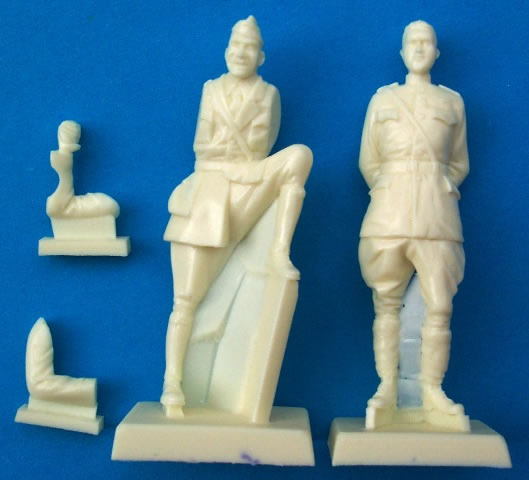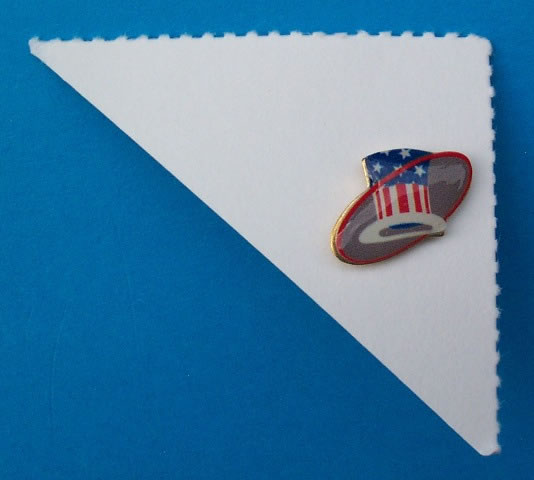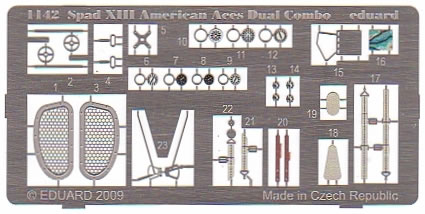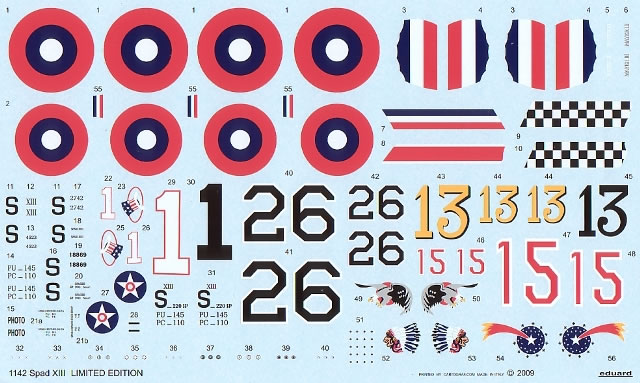|
SPAD XIII
Dual Combo

Eduard, 1/48 scale
S
u m m a r y |
| Catalogue Number: |
Eduard Kit No. 1142 - Dual Combo SPAD XIII (American Eagles) |
| Scale: |
1/48 |
| Contents and Media: |
170 parts in tan coloured plastic; 29 photo-eched parts; 6 clear parts; markings for four aircraft |
| Price: |
USD$74.95 available online from Eduard
and hobby retailers worldwide |
| Review Type: |
FirstLook |
| Advantages: |
Superb overall detail; one piece wings with commendably thin trailing edges; nicely rendered fuselage stringers and rib tapes; excellent use photo etched parts; decals in perfect register with minimal thin carrier film; well cast figures and the inclusion of a squadron pin. |
| Disadvantages: |
Experience helpful to obtain a good fit. |
| Conclusion: |
An admirable release that packages Eduard’s reputable SPAD 13 with extra goodies to showcase the aces that made this aircraft famous. |
Reviewed by
Rob Baumgartner

Eduard's 1/48 SPAD XIII Dual Combo is available online from Squadron.com
French, British, Italian, Belgian, and American pilots all flew the Spad 13 and it’s the latter group that this release focuses on.
This is a “Dual Combo” boxing and as such contains parts to build two aircraft. They represent the late version of the S.13 which had modified wing tips that featured a more squared off appearance. These plywood “pockets” proved unsatisfactory so new wings were designed to incorporate this facet and this is what we have embodied here.
As expected the box is packed to the brim and contains 170 plastic parts which are split between the two models. Each also has a fret of photo-etched parts which realizes a further 29 items for the aircraft. A choice of 3 windscreens is supplied in the usual clear material and a generous decal sheet allows the modeller to choose between 4 subjects.
The contents were compared to the respected scale drawings of Doug Carrick and the outlines matched the kits parts perfectly. These 1992 plans can be found in Windsock Datafile 32, and give the builder a sound basis from which to start.
Painting the tires and windscreen can be an onerous task, so to help ease the pain, Eduard also supply a useful sheet of pre-cut adhesive masks.
Just like the debut release of their Fokker Dr.I, the manufacturers have included a few extra “goodies”.
They come in the form of two resin figures with each representing one of the decal options. Eddie Rickenbacker is seen in the familiar pose where he relaxes on the wheel of SPAD 13 serial S4523 in late September 1918. Meanwhile Frank Luke assumes a nonchalant appearance in front of the remains of his 13th victim, an LVG from Flieger Abteilung 36.

Both manifestations are taken from photographs and the results are beautifully cast with no air bubbles or blemishes to be seen anywhere.
The other surprise is a “Hat in the Ring” pin, an emblem worn by the aircraft of the 94th Aero Squadron.

Accompanying these is a couple of portraits of the two men. They represent an excellent likeness to both aces and the size of 15cm by 21cm makes them ideal for framing.
All of the parts on the tan coloured sprues were crisply moulded with any ejector pin or sink marks being hidden after final assembly.
The cockpit is where the action begins and Eduard has done a fine job of matching the items found on the Memorial Flight Association’s restored Kellner-built Spad 13. No less than 30 parts make up this area and that includes coloured photo etched items for the seat belts, instrument dials and even a map.
Also seen on the fret are gun sights, throttles, and best of all, the side panels for the forward fuselage.

The wings are superbly done with thin trailing edges and delicate raised rib tapes. A subtle representation of the stitching is also a plus as is the correctly featured ply sheathing that appears on the leading edge of the upper surfaces. These are both done as single piece items and greatly ease the building process.
The unconventional split of the fuselage and top decking is a clever piece of engineering. It means that the sublime stringer detail is retained after assembling and this applies equally to the tailplane.
Assembly is a challenge on this kit as one finds it hard to contain the cockpit parts between the fuselage halves. A lot of dry-fitting is needed with the shelf as well as some necessary paring from the underside of the top deck. The port side of the fuselage also causes a concern as it falls short of the front cowling and needs to be shimmed for an acceptable fit.
The instruction booklet clearly shows where everything should go which is vital considering the wealth of parts. A rigging diagram is also included as well as colour images of all the markings options.
Marking Options
Four choices are supplied on the well printed decal sheet. All items were in perfect register with minimal carrier film.

- Edward V. Rickenbacker, 94th Aero Squadron – Summer, 1918
This Kellner –built SPAD 13 is the famous one in which Rickenbacker scored 20 victories. The camouflage colours are in the pattern used by that manufacturer and on it are displayed Rickenbacker’s white “1” and the 94th Aero Squadron’s “Hat in the ring” insignia.
The markings on this machine (serial S4523) changed a few times throughout its life, even extending to the style and position of the serial number on the rudder. One particular photograph of S4523 is interesting in that it shows only 3 painted fuselage bullet repair patches, cut off and snubbed exhaust pipes, as well as enclosed piping connecting the upper wing.
Thus one should check their references carefully to represent the correct details against any particular timeframe.
- Frank Luke, 27th Aero Squadron – September, 1918
Due to Luke’s aggressive “style” of air fighting he went through quite a few aircraft in very short time. There is only one known photograph that shows any sort of markings relating to an aircraft of his. Its serial number is unknown but it was a Blériot-built machine.
The aircraft number he was photographed in front of was “26” and consistent with this is the blue cowl ring designating the 3rd flight.
Most sources depict the upper wing diagonal stripe with 4 rows of black and white checks. Eduard has chosen to use 3.
- Gorman deFreest Larner, 103rd Aero Squadron – 1918
This is another Bleriot- built aircraft and as such wears a different pattern of colours to Rickenbacker’s Kellner made machine. The personal number is a yellow “13” and more colour is added by the Indian head of the 103rd Aero Squadron.
Gorman deFreest Larner was born on 5 July 1897 in Washington DC. He was judged too young for the Air Service and decided to try his luck elsewhere. A trip to France saw him accepted there and he joined SPA 86 with which he claimed 2 victories.
After being commissioned into the USAS in April 1918, he went to the 103rd Aero as a flight commander. The end of the war saw him with a final tally of 7 confirmed conquests.
- Jacques M. Swaab, 22nd Aero Squadron – Fall, 1918
This is one of the most colourful choices and is a Bleriot-built SPAD that Swaab received on 3 November 1918. He named it “Mayer III” after his father and decorated the unit emblem with his victory markings.
Swaab was the highest scoring ace with the 22nd Aero and finished the conflict with 10 victories.
Interestingly one of his post-war jobs was as a technical advisor for the Hollywood film “Dawn Patrol”.
This “Dual Combo” is much more than just two kits.
Not only do they provide a choice of interesting markings for the two kits presented, Eduard also focus specific attention on two of the combatants. By providing figures that represent these pilots, and portraits to accompany them, the modeller is able to create a tribute to their favourite ace.
This is a welcome package that exposes the modeller to more than just building an aeroplane.
Thanks to Eduard for the sample
Review Text Copyright © 2009 by Rob Baumgartner
Page Created 6 July, 2009
Last updated
6 July, 2009
Back to HyperScale Main Page
Back to Reviews Page

|
